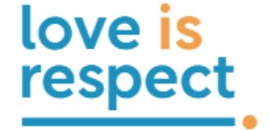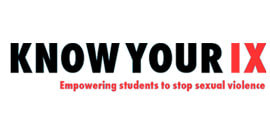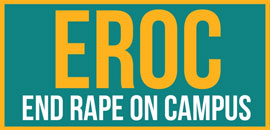|
EDUCATION about and PREVENTION against gender and relationship violence
|
|
Our Mission |
Our mission is to provide quality educational programming that prevents gender and relationship violence. Working through secondary schools, colleges and universities, and community-based organizations and agencies, Jana’s Campaign delivers specialized prevention strategies and curricula that is designed to prevent violence, build healthy relationships, and create new social norms.
|
Our Vision |
Our vision is that Jana’s Campaign will play a significant role ending gender and relationship violence and be a catalyst for social change. We believe that by working with thousands of other activists from around the world, this social disease can be eradicated in a single generation. Simply, we plan to do our part.
|
Our Philosophy |
Our Strategy. The massive scale of social problems like gender and relationship violence is often viewed as so overwhelming that it hinders our ability to act. The magnitude of the problem often discourages many of us and lends us to believe that we are helpless in making a real difference. We at Jana’s Campaign view this situation differently. We recast the larger social problem of gender violence as series of manageable issues--each with identifiable opportunities and solutions. In essence, gender and relationship violence can be effectively addressed by tackling smaller related issues, one by one, over an extended period of time. Many smaller incremental changes and improvements equals transformational change.
“Few will have the greatness to bend history; but each of us can work to change a small portion of events, and in total of all those acts will be written the history of a generation… it is from numberless diverse acts of courage that human history is thus shaped.” — Robert Kennedy We at Jana’s Campaign endorse a strategy of pursuing small victories to address this massive social disease. To us, many small victories equals substantial progress. Through our various educational and prevention efforts we believe the sum total of many minor improvements can substantially contribute to reducing gender and relationship violence on a large scale. We have an unwavering commitment to results and impact that produces a series of small victories. Like building blocks, these improvements and program successes build on each other and reinforce positive change. We are a group of grassroots activists who have built an organization that focuses on producing results and creating real impact. |
Our Prevention Approach |
First and foremost, we believe that gender and relationship violence is preventable. The ultimate goal of our programs is to stop violence before it starts. Our efforts include primary, secondary, and tertiary prevention approaches. Second, we believe that prevention efforts must address all levels of the social ecological model. This calls for comprehensive behavioral and attitudinal changes at the individual, relationship, community, and social levels. Finally, we utilize evidence-based prevention strategies and practices that illustrate the greatest impact. Our educational programs are designed to raise awareness, reduce risk factors while supporting protective measures, engaging bystanders, promoting healthy and respectful relationships, and encouraging the development of new social norms.
|
Our Prevention Model |
Our prevention model is based on six elements which provides the most comprehensive approach to preventing gender and relationship violence. They include:
|
Our Public Health Approach |
We at Jana’s Campaign believe gender and relationship violence is a severe public health issue that affects millions around the world and we understand the need to educate others on the health linkages between these issues in order to assist with prevention of gender and relationship violence as a whole. Gender-Based Violence (GBV) refers to harmful acts directed at an individual based on their gender. It is rooted in gender inequality, the abuse of power, harmful norms; and includes physical, sexual, verbal, emotional, and psychological abuse, threats, coercion, and economic or educational deprivation. While women and girls are the most at risk and the most affected by gender-based violence; boys, men, and sexual and gender minorities also experience gender-based violence (womenforwomen.org). Relationship Violence is a pattern of behaviors used by one partner to maintain power and control over another partner in a relationship. This type of violence can occur among heterosexual or same-sex couples and does not require sexual intimacy (CDC, 2020).
Background of Gender and Relationship Violence as a Public Health Problem Jana’s Campaign recognizes gender and relationship violence as a prevalent public health issue because globally, an estimated 736 million women—almost one in three—have been subjected to gender based violence, relationship violence, or non-partner sexual violence at least once in their life (unwomen.org) and 1 in 7 men have been victims of severe physical violence (e.g. beating, burning, strangling) by an intimate partner in their lifetime (ncadv.org, 2020). Because of this frequency and severity; it makes it a much larger problem in public health terms. Women who experience GBV and relationship violence can suffer violent deaths either directly – through homicide – or indirectly, through suicide, maternal causes, and AIDS. A shocking 40-60 percent of murders of women in the USA are perpetrated by their intimate partners. Violence is also an important cause of morbidity from multiple mental, physical, sexual and reproductive health outcomes, and it is similarly linked with known risk factors such as alcohol and drug use, smoking, and risky sexual behaviors (Garcia-Moreno et al, 2011). Gender and Relationship Violence and Pregnancy Violence during pregnancy has been associated with an increased risk of miscarriage, premature delivery, and low birth weight. In fact, a woman’s pregnancy is a high-risk period for the initiation and escalation of relationship violence, and is the leading cause of maternal mortality in the USA, UK, and Australia (Garcia-Moreno et al, 2011). Long-Term Health Concerns Jana’s Campaign understands that GBV has specific, long-term, negative health outcomes for victims, even after the abuse has ended. These negative effects can manifest as poor health status, poor quality of life, and the overall high use of health services. It has also been found that women who have experienced GBV have significantly more than average self-reported gastrointestinal symptoms and diagnosed functional gastrointestinal disorders. Experiencing psychological GBV is associated with a significant increase in risk of developing conditions such as: disabilities preventing work, chronic neck or back pain, arthritis, migraines or other frequent headaches, stammer or stutter, problems seeing with glasses, chronic pelvic pain, transmitted infections, stomach ulcers, spastic colon, and indigestion (Hill et al, 2009). Physical GBV was found to be correlated to hearing loss, cardiovascular problems, gastric reflux, and bladder or kidney infections. Evidence suggests that women and men who are exposed to violence by their partners also show psychological consequences: higher level of depression, anxiety and phobias (Hill et al, 2009). Dating Violence and Late Adolescent Health Jana’s Campaign acknowledges how cell phones and other electronic mechanisms provide pathways for increased monitoring and harassment of dating or romantic partners and may exacerbate jealousy. Yet, little is known about how excessive monitoring through mechanisms such as cell phones or email relate to late adolescent health. Among females, studies have shown an association between having a history of physical and/or sexual dating violence victimization and poor health during adolescence—including depression, anxiety and stress symptoms, suicide ideation or attempts, smoking, alcohol and drug use, disordered eating (e.g., using laxatives and/or vomiting to lose weight), and lessened quality of life. Male victims of physical and/or sexual dating violence during adolescence are at increased risk of disordered eating; anxiety, stress symptoms and depression; suicidal ideation and/or attempts, smoking, alcohol and drug use, and diminished emotional well-being. Both physical and emotional types of dating violence increase anxiety and depression in adolescent females and males (Bonomi et al, 2013). Resources Used Bonomi, A. E., Anderson, M. L., Nemeth, J., Rivara, F. P., & Buettner, C. (2013). History of dating violence and the association with late adolescent health. BMC Public Health, 13(1). doi:10.1186/1471-2458-13-821 Facts and figures: Ending violence against women: What we do. (2021, March). Retrieved June 16, 2021, from https://www.unwomen.org/en/what-we-do/ending-violence-against-women/facts-and-figures Garcia-Moreno, C., & Watts, C. (2011). Violence Against Women: An Urgent Public Health Priority. Bulletin of the World Health Organization, 89(1), 2-2. doi:10.2471/blt.10.085217 Hill, T. D., Schroeder, R. D., Bradley, C., Kaplan, L. M., & Angel, R. J. (2009). The Long-Term Health Consequences of Relationship Violence in Adulthood: An Examination of Low-Income Women From Boston, Chicago, and San Antonio. American Journal of Public Health, 99(9), 1645-1650. doi:10.2105/ajph.2008.151498 NCADV: National Coalition Against Domestic Violence. (2020). Retrieved from https://ncadv.org/STATISTICS Olofsson, N., Lindqvist, K., Gadin, K. G., & Danielsson, I. (2009). Violence Against Young Men and Women: A Vital Health Issue. The Open Public Health Journal, 2(1), 1-6. doi:10.2174/1874944500902010001 Sanjel, S. (2015). Gender-Based Violence: A Crucial Challenge for Public Health. Kathmandu University Medical Journal, 11(2), 179-184. doi:10.3126/kumj.v11i2.12499 |










